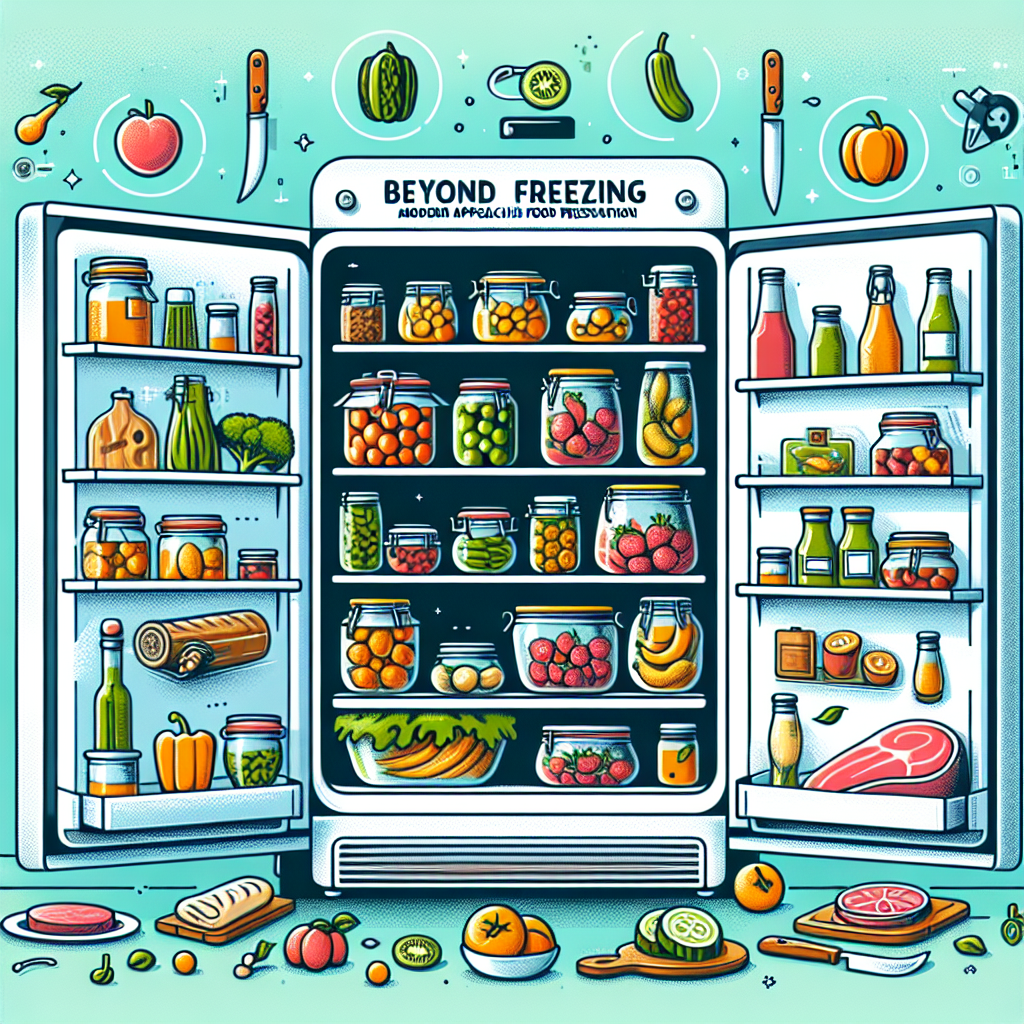[ad_1]
**Beyond Freezing: Modern Approaches to Food Preservation**
In the journey of human civilization, food preservation has always played a pivotal role, evolving with time from traditional methods like salting, smoking, and fermenting, to modern technologies such as refrigeration and canning. However, as global populations burgeon and environmental concerns rise, the quest for innovative and efficient food preservation techniques has intensified. This article delves into some of the cutting-edge approaches that go beyond mere freezing, seeking not just to extend the shelf life of food but also to preserve its nutritional value, taste, and safety.
### The Advent of High-Pressure Processing (HPP)
High-Pressure Processing, often known as HPP, is a method where food products are subjected to extremely high pressures (up to 600 MPa or 87,000 psi), with the aim of inactivating microbial life that contributes to food degradation. Unlike traditional heat treatments, HPP is carried out at or near room temperature, ensuring that the nutritional and sensory attributes of the food are retained. This method is particularly effective for juices, meats, and ready-to-eat meals, offering an extension in shelf life and a guarantee of safety without the compromise on taste typical of thermal processing.
### Pulsed Electric Fields (PEF)
Pulsed Electric Fields applies short bursts of high voltage to liquid foods, like juices and soups, traversing between two electrodes. This process induces cell membrane perforation in microorganisms, leading to their inactivation. The notable advantage of PEF is its minimal heat generation, which means that the impact on a food’s sensory and nutritional properties is substantially less compared to conventional heat treatments. As a non-thermal preservation method, PEF has shown promise in extending the shelf life of liquid foods while retaining their “fresh-like” qualities.
### Cold Plasma Technology
Emerging as a revolutionary approach in the food preservation domain, Cold Plasma involves the application of ionized gas at low temperatures to food surfaces. This technology is poised to redefine surface disinfection processes across various food categories, including fruits, vegetables, and even dry nuts. Cold Plasma operates by generating reactive species that target and deactivate microbial contaminants, all without elevating product temperatures significantly. Its effectiveness against a wide range of pathogens, combined with the minimal impact on food quality, underscores its potential as a versatile preservation technique.
### Edible Coatings
Another innovative strategy gaining traction is the use of edible coatings. Derived from naturally occurring substances like proteins, polysaccharides, and lipids, these coatings are applied directly to food items, forming a protective barrier against moisture loss, oxidation, and microbial growth. Beyond preservation, edible coatings can also enhance the nutritional profile of foods by incorporating additional vitamins, antioxidants, or probiotics. As a sustainable alternative to conventional packaging, they address both food wastage and environmental concerns, presenting a win-win solution.
### Superchilling Technology
Superchilling, reducing the temperature of food products just below their freezing point without solidifying them, strikes an intriguing balance between refrigeration and freezing. This technique, applied primarily to fish and meat products, extends their shelf life significantly by slowing down microbial growth and biochemical reactions. Superchilled products retain a fresh taste and texture similar to that of their unfrozen counterparts, making this method a preferred choice for preserving quality in the food supply chain.
### FAQs on Modern Food Preservation Techniques
**Q1: Are modern food preservation techniques safe?**
A1: Yes, methods like HPP, PEF, Cold Plasma, and others have been extensively researched and deemed safe. They are regulated and monitored by international food safety authorities to ensure their compliance with health standards.
**Q2: Do these techniques alter the nutritional content of food?**
A2: One of the primary advantages of these modern techniques, especially non-thermal ones like HPP and PEF, is their minimal impact on the nutritional and sensory qualities of food. They aim to preserve, if not enhance, the original nutritional profile of food products.
**Q3: Are foods preserved using these methods more expensive?**
A3: Initially, the cost may be higher due to the specialized equipment and processing required. However, as these technologies become more widespread and efficient, the costs are expected to decrease, making them more competitive with traditional preservation methods.
**Q4: Can these modern techniques be used for all types of food?**
A4: While highly versatile, the applicability of each technique varies depending on the food’s properties and the desired preservation outcomes. Some are more suited to liquid foods, while others excel with solids or surfaces. Ongoing research continues to expand their use to a broader range of food products.
**Q5: What impact do these preservation techniques have on the environment?**
A5: Many of these modern methods, such as edible coatings and HPP, offer more sustainable alternatives to traditional preservation and packaging methods. By extending the shelf life of foods, they reduce waste. Their energy-efficient and minimal processing requirements also contribute to lower carbon footprints compared to conventional techniques.
In conclusion, as we navigate the challenges of feeding a growing global population amid environmental concerns, modern food preservation technologies offer an array of innovative solutions. These methods not only ensure food safety and extend shelf life but also align with the need for sustainability and minimal environmental impact. As research progresses and these technologies advance, the future of food preservation looks both promising and exciting, with the potential to revolutionize how we store, consume, and enjoy our food for years to come.
[ad_2]

Leave a Reply